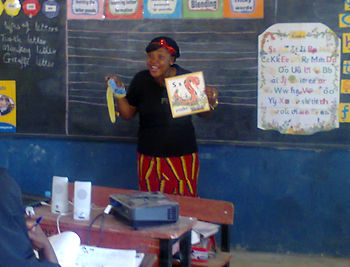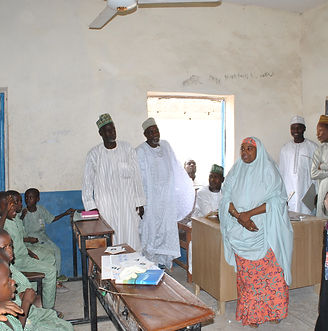


Jolly Phonics Training for Primary 1 Teachers
Zamfara State Jolly Phonics Project Updates


A trainer shows the class her hand-made puppet, 'Sylvester' to teach the sound /s/
Primary 1 teachers in Anka are shown how form letters on the ground to cater for children with different learning styles
A questionnaire to assess the participants’ understanding of the basic skills for teaching Jolly Phonics was administered on the participants. Five (5) participants were selected from each class and ten (10) classes from the four (4) centres making a total of two hundred (200) respondents randomly selected for processing.
Below are charts showing the result processed from the participants’ responses.
a. Knowledge of Letter Sounds
Participants were asked to write as many letter sounds that they know. The chart below
show the result from their responses.

b. Counting of Sounds in Words
Participants were asked to count the number of letter sounds in a set of seven (7) words.
There are thirty (30) sounds in the 7 words. The chart below shows how participants
responded to the question. This skill is essential for showing pupils how to segment words into phonemes in order to write.

C. Identification of Consonant Blends
Participants were asked to identify the consonant blends in a set of seven (7) words
presented to them. There were three (3) consonant blends in the set.

Implementation of Jolly Phonics
All participating schools were directed by Zamfara State Universal Basic Education Board to commence teaching with Jolly Phonics in January 2014. 60,000 primary one children have been given a black and white Jolly Phonics Pupil's Book, and teachers use flashcards, posters and Jolly Songs to make the lessons engaging. In some instances the songs have been uploaded onto mobile phones and are played out to the children.Click on the video below to watch pupils in Zamfara State learning the letter sounds using Jolly Phonics actions.

Monitoring and Mentoring
Summary:
Working through a team of four academics, two project coordinators and SUBEB officials, Universal Learning Solutions has monitored more than 500 schools so far through a combination of in-depth monitoring, including teacher observations and interviews, as well and brief monitoring visits. The team give prizes to teachers who show dedication to teaching phonics in schools and text messages are sent to all teachers giving support and encouragement. Where challenges are observed, the monitoring team inform the government immediately and action is taken. For example, when it was discovered that a school had no trained teachers, trained teachers were transferred from other schools. Universal Learning Solutions UK staff have made two visits to Zamfara State, where teaching and pupils were observed, revealing that many pupils are now able to read two syllable words and some are able to read sentences. A team of academics is measuring pupils' reading and writing ability by using a combination of BURT standardised reading test and Early Grade Reading Assessment tools across sixteen randomly selected focus schools.
Latest Monitoring News:
August 2014
The monitoring team held a 5 day 'retreat', where they carefully examined data from in-depth visits to 288 project schools in June 2014. The data will help the team to plan for the next quarter of the project. Some of the data is summarised below:
86.3% of schools have special time slots for Jolly Phonics;
75.4% of teachers were observed to be either good or excellent at implementing Jolly Phonics (a number of measurements were used such as: effective use of materials, progress with pupil books, is teacher attempting to teach with synthetic phonics, do the children show signs of learning and reading improvement in their workbooks?)
12.6% of teachers received 'excellent' competence ratings, whilst 37.6% received 'good' ratings (based on number of letter sounds pronounced correctly, description of key reading skills and ability to count phonemes in words)
“I am very happy with the Jolly Phonics method. It is simple and interesting...the songs and actions help the pupils to comprehend."
(Head teacher, Bungudu LGA, April 2014)
November 2014
The monitoring team are once again visiting schools to ensure that the new school year brings continued Jolly Phonics implementation. The project coordinators are drawing up key messages for teachers as pupils now move to Primary 1. Every participating teacher will soon receive weekly SMS text messages as a way of ensuring that teachers remain well-guided and motivated throughout the year. Further, the academic team are about to commence testing of pupils who have been using Jolly Phonics for one full year. Watch this space for the results....
During November and December 2013, Universal Learning Solutions facilitated the training of more than 2000 Primary 1 teachers and headteachers in Zamfara State. Each participant received four days of Jolly Phonics training by an experienced Nigerian Jolly Phonics trainer. Training took place in four centres, namely Kaura Namoda, Anka, Talata Marafa and Gusau. Participants have been very enthusiastic, and have especially enjoyed learning the Jolly Phonics actions, learning how to use puppets, make sound boxes, and lots more. Below are some photos from the training so far and some data from the training reports.
Project Photos





ULS Directors Louise Gittins and Naomi Foxcroft inspect the new Monitoring Office, March 2014
Children make the /c/ sound using actions during a monitoring trip in February 2014
Naomi Foxcroft gives a prize to an excellent teacher from Township Model Primary School, March 2013
Members of the State Universal Basic Education Board, project coordinators and academics visit Township Model Primary School, March 2013
The Jolly Phonics Monitoring office, donated by Zamfara State Universal Basic Education Board